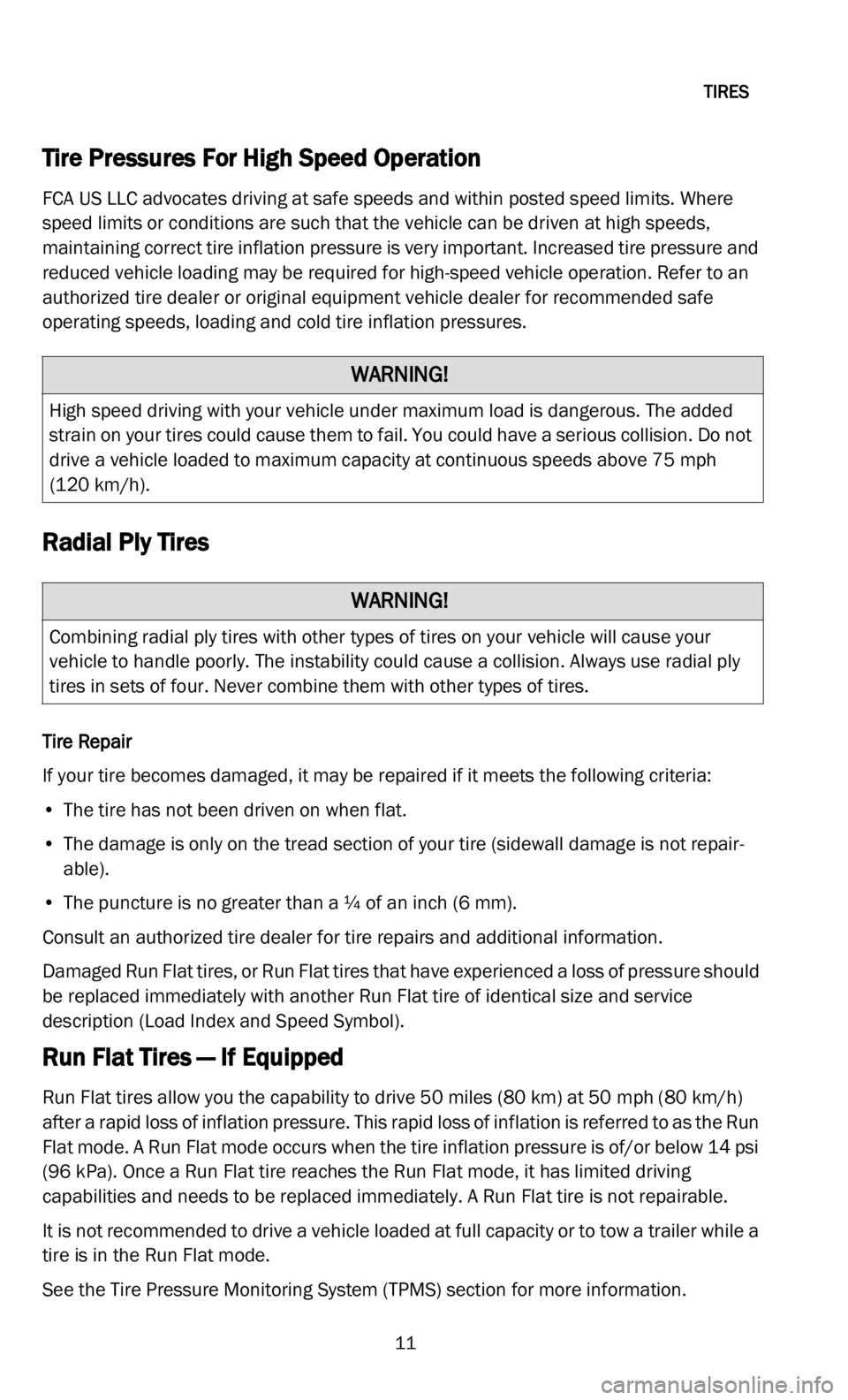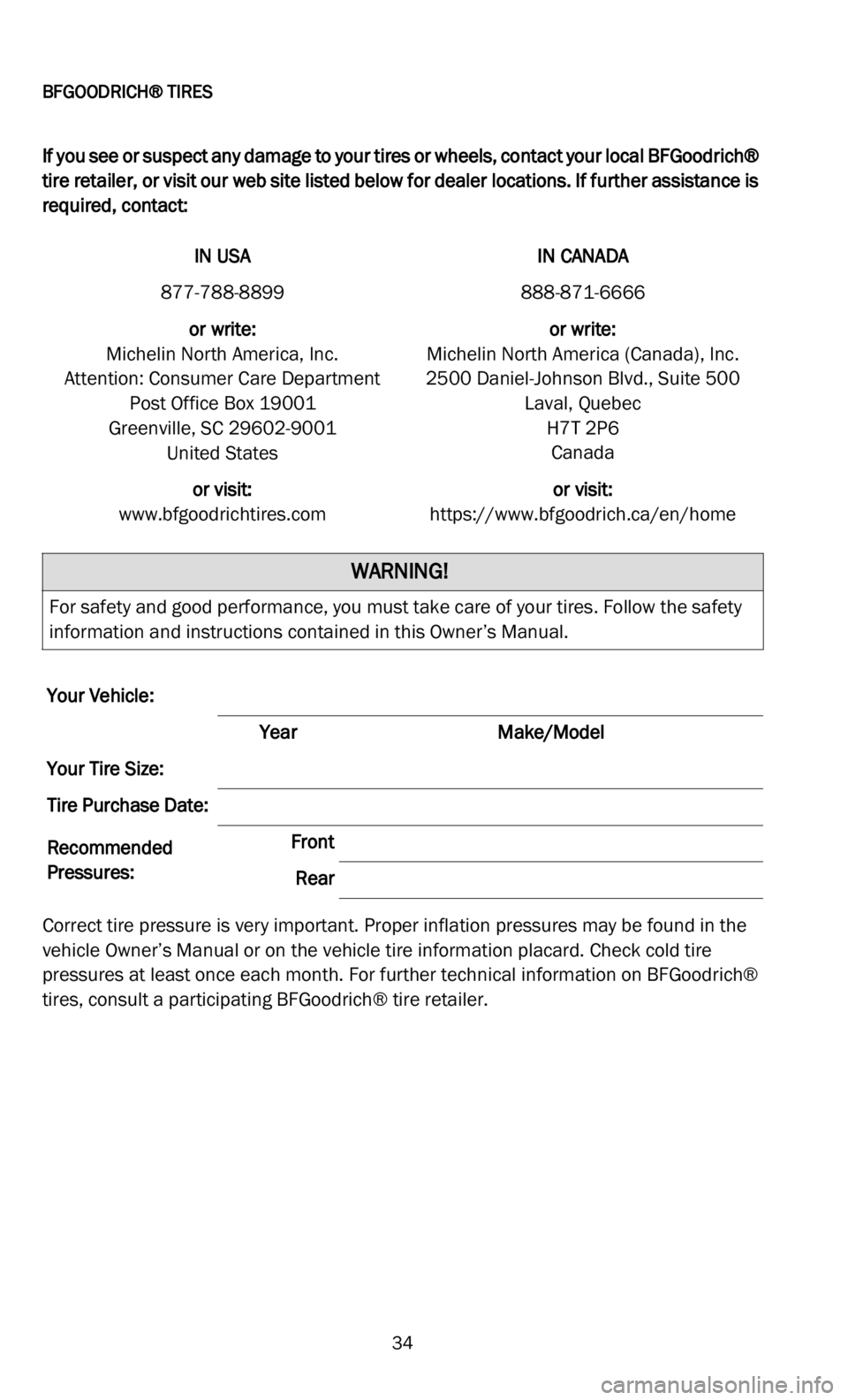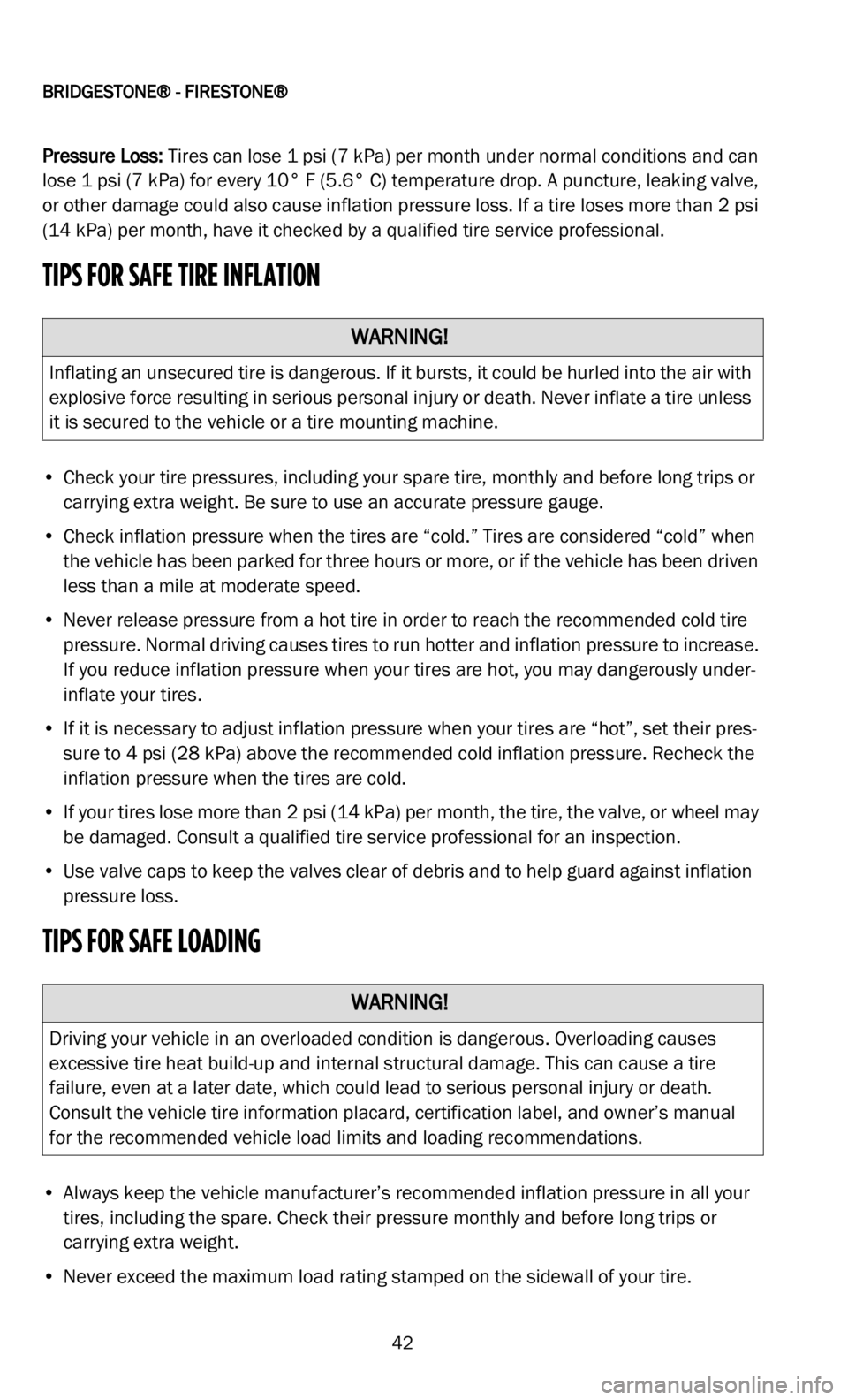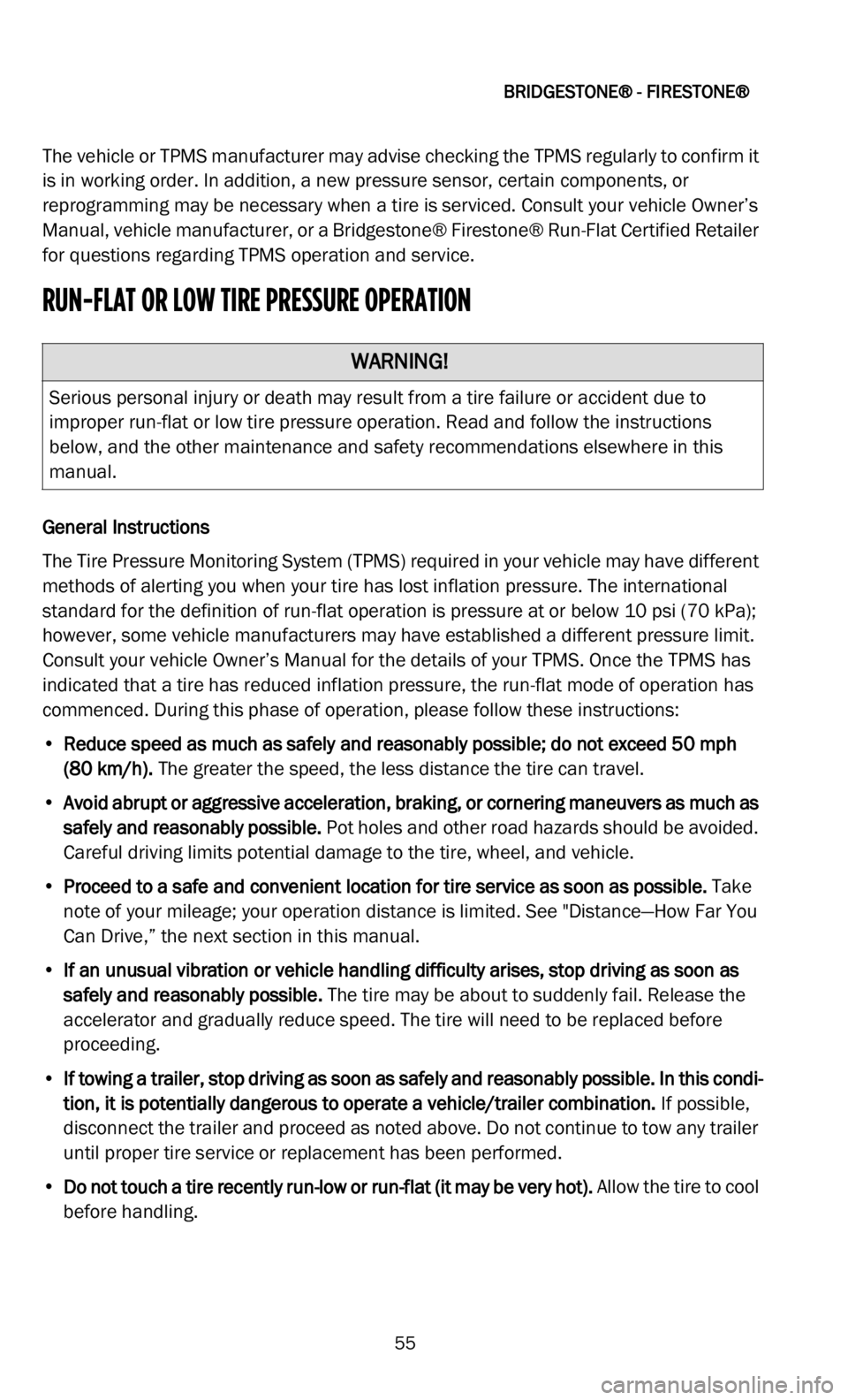ECO mode DODGE DURANGO 2022 Vehicle Warranty
[x] Cancel search | Manufacturer: DODGE, Model Year: 2022, Model line: DURANGO, Model: DODGE DURANGO 2022Pages: 200, PDF Size: 6.72 MB
Page 12 of 200

TIRES
11
Tire Pressures For High Speed Operation
FCA US LLC advocates driving at safe speeds and within posted speed limits. Where
speed limits or conditions are such that the vehicle can be driven at high speeds,
maintaining correct tire inflation pressure is very important. Increased tire pressure and
reduced vehicle loading may be required for high-speed vehicle operation. Refer to an
authorized tire dealer or original equipment vehicle dealer for recommended safe
operating speeds, loading and cold tire inflation pressures.
Radial Ply Tires
Tire Repair
If your tire becomes damaged, it may be repaired if it meets the following criteria:
• The tire has not been driven on when flat.
• Th
e damage is only on the tread section of your tire (sidewall damage is not repair -
a b
le).
• The puncture is no greater than a ¼ of an inch (6 m
m).
Consult an authorized tire dealer for tire repairs and additional information.
Damaged Run Flat tires, or Run Flat tires that have experienced a loss of pressure should
be
replaced immediately with another Run Flat tire of identical size and service
description (Load Index and Speed Symbol).
Run Flat Tires — If Equipped
Run Flat tires allow you the capability to drive 50 miles (80 km) at 50 mph (80 km/h)
aft
er a rapid loss of inflation pressure. This rapid loss of inflation is referred to as the Run
Flat mode. A Run Flat mode occurs when the tire inflation pressure is of/or below 14 psi
(96 kPa). Once a Run Flat tire reaches the Run Flat mode, it has limited driving
capabilities and needs to be replaced immediately. A Run Flat tire is not repairable.
It is not recommended to drive a vehicle loaded at full capacity or to tow a trailer while a
tir
e is in the Run Flat mode.
See the Tire Pressure Monitoring System (TPMS) section for more information.
WARNING!
High speed driving with your vehicle under maximum load is dangerous. The added
strain on your tires could cause them to fail. You could have a serious collision. Do not
drive a vehicle loaded to maximum capacity at continuous speeds above 75 mph
(1 2
0 km/h).
WARNING!
Combining radial ply tires with other types of tires on your vehicle will cause your
vehicle to handle poorly. The instability could cause a collision. Always use radial ply
tires in sets of four. Never combine them with other types of tires.
Page 35 of 200

BFGOODRICH® TIRES
34
If you see or suspect any damage to your tires or wheels, contact your local BFGoodrich®
tire retailer, or visit our web site listed below for dealer locations. If further assistance is
required, contact:
Correct tire pressure is very important. Proper inflation pressures may be found in the
ve
hicle Owner’s Manual or on the vehicle tire information placard. Check cold tire
pressures at least once each month. For further technical information on BFGoodrich®
tires, consult a participating BFGoodrich® tire retailer. IN USA
IN CANADA
877-788-8899 888-871-6666
or write:
Michelin North America, Inc.
Attention: Consumer Care Department Post Office Box 19001
Greenville, SC 29602-9001 United States or write:
Michelin North America (Canada), Inc.
2500 Daniel-Johnson Blvd., Suite 500 Laval, QuebecH7T 2P6Canada
or visit:
www.bfgoodrichtires.com or visit:
https://www.bfgoodrich.ca/en/home
WARNING!
For safety and good performance, you must take care of your tires. Follow the safety
information and instructions contained in this Owner’s Manual.
Your Vehicle:
Year Make/Model
Your Tire Size:
Tire Purchase Date:
Recommended
P r
essures: Front
Rear
Page 43 of 200

BRIDGESTONE® - FIRESTONE®
42
Pressure Loss: Tires can lose 1 psi (7 kPa) per month under normal conditions and can
lose 1 psi (7 kPa) for every 10° F (5.6° C) temperature drop. A puncture, leaking valve,
or other damage could also cause inflation pressure loss. If a tire loses more than 2 psi
(14 kPa) per month, have it checked by a qualified tire service professional.
TIPS FOR SAFE TIRE INFLATION
• Check your tire pressures, including your spare tire, monthly and before long trips or carrying extra weight. Be sure to use an accurate pressure gauge.
• C heck inflation pressure when the tires are “cold.” Tires are considered “cold” when
t
he vehicle has been parked for three hours or more, or if the vehicle has been driven
less than a mile at moderate speed.
• N ever release pressure from a hot tire in order to reach the recommended cold tire
p
ressure. Normal driving causes tires to run hotter and inflation pressure to increase.
If you reduce inflation pressure when your tires are hot, you may dangerously under -
inflate your tires.
• I f it is necessary to adjust inflation pressure when your tires are “hot”, set their pres -
s
ure to 4 psi (28 kPa) above the recommended cold inflation pressure. Recheck the
i n
flation pressure when the tires are cold.
• I f your tires lose more than 2 psi (14 kPa) per month, the tire, the valve, or wheel may
b
e damaged. Consult a qualified tire service professional for an inspection.
• U se valve caps to keep the valves clear of debris and to help guard against inflation
p
ressure loss.
TIPS FOR SAFE LOADING
• Always keep the vehicle manufacturer’s recommended inflation pressure in all your tires, including the spare. Check their pressure monthly and before long trips or
carrying extra weight.
• N ever exceed the maximum load rating stamped on the sidewall of your tire.
WARNING!
Inflating an unsecured tire is dangerous. If it bursts, it could be hurled into the air with
explosive force resulting in serious personal injury or death. Never inflate a tire unless
it is secured to the vehicle or a tire mounting machine.
WARNING!
Driving your vehicle in an overloaded condition is dangerous. Overloading causes
excessive tire heat build-up and internal structural damage. This can cause a tire
failure, even at a later date, which could lead to serious personal injury or death.
Consult the vehicle tire information placard, certification label, and owner’s manual
for the recommended vehicle load limits and loading recommendations.
Page 56 of 200

BRIDGESTONE® - FIRESTONE®
55
The vehicle or TPMS manufacturer may advise checking the TPMS regularly to confirm it
is in working order. In addition, a new pressure sensor, certain components, or
reprogramming may be necessary when a tire is serviced. Consult your vehicle Owner’s
Manual, vehicle manufacturer, or a Bridgestone® Firestone® Run-Flat Certified Retailer
for questions regarding TPMS operation and service.
RUN-FLAT OR LOW TIRE PRESSURE OPERATION
General Instructions
The Tire Pressure Monitoring System (TPMS) required in your vehicle may have different
m e
thods of alerting you when your tire has lost inflation pressure. The international
standard for the definition of run-flat operation is pressure at or below 10 psi (70 kPa);
however, some vehicle manufacturers may have established a different pressure limit.
Consult your vehicle Owner’s Manual for the details of your TPMS. Once the TPMS has
indicated that a tire has reduced inflation pressure, the run-flat mode of operation has
commenced. During this phase of operation, please follow these instructions:
• Reduce speed as much as safely and reasonably possible; do not exceed 50 m
ph
(8
0 km/h). The greater the speed, the less distance the tire can travel.
• Avoid abrupt or aggressive acceleration, braking, or cornering maneuvers as much as
s
afely and reasonably possible. Pot holes and other road hazards should be avoided.
Careful driving limits potential damage to the tire, wheel, and vehicle.
• Proceed to a safe and convenient location for tire service as soon as possible.
Take
note of your mileage; your operation distance is limited. See "Distance—How Far You
Can Drive,” the next section in this manual.
• If an unusual vibration or vehicle handling difficulty arises, stop driving as soon as
s
afely and reasonably possible. The tire may be about to suddenly fail. Release the
accelerator and gradually reduce speed. The tire will need to be replaced before
proceeding.
• If towing a trailer, stop driving as soon as safely and reasonably possible. In this condi -
t
ion, it is potentially dangerous to operate a vehicle/trailer combination. I
f possible,
disconnect the trailer and proceed as noted above. Do not continue to tow any trailer
until proper tire service or replacement has been performed.
• Do not touch a tire recently run-low or run-flat (it may be very hot).
Allow the tire to cool
before handling.
WARNING!
Serious personal injury or death may result from a tire failure or accident due to
improper run-flat or low tire pressure operation. Read and follow the instructions
below, and the other maintenance and safety recommendations elsewhere in this
manual.
Page 57 of 200

BRIDGESTONE® - FIRESTONE®
56
DISTANCE—HOW FAR YOU CAN DRIVE
Factors affecting run-flat or low tire pressure operating distance include vehicle speed,
load, and maneuvering; the amount of inflation pressure loss; the extent of any tire
damage; and ambient temperature.
The tire may be marked on the sidewall with run-flat or low tire pressure operating speed
an
d/or distance limitations, which vary by tire design and vehicle application (consult
your vehicle owner’s manual). By international standard, RFT tires have a baseline
limitation in run-flat mode of the following:
NOTE:
• M aximum distance values are determined under controlled conditions, which may
v
ary in actual use.
• Y our mileage capability may be less, or more, depending on your specific operating
c
onditions.
• I f in doubt, do not exceed the 50
mile (80 km) limitation.
• S eek tire service as soon as possible to minimize tire damage.
SPECIAL SERVICE AND REPAIR ISSUES
Run-Flat Certified Retailers
Because of the advanced technology and design of Run-Flat tires and the required Tire
Pr
essure Monitoring Systems (TPMS), Bridgestone® Firestone® Run-Flat Certified
Retailers are specially trained to sell and service RFT tires.
Run-Flat Certified Retailers have the necessary equipment and are specially trained to
p r
operly mount and demount RFT tires and to handle TPMS devices. Conventional
mounting equipment may irreparably damage RFT tires and an improper repair is unsafe
and will void the Limited Warranty. Accordingly, it is important to go to a Bridgestone®
Firestone® Run-Flat Certified Retailer for tire maintenance and replacement.
Call toll-free 1-877-BFS-4RFT or, 87
7-237-4738 or visit www.bridgestonetire.com to
locate the nearest Bridgestone® Firestone® Run-Flat Certified Retailer.
Inspection after Run-Flat or Low Pressure Operation
Following run-flat or low tire pressure operation, or in the event of any other tire damage
or
unusual condition, it is very important to obtain a proper and complete tire evaluation
as soon as possible.
Rotation
Follow the vehicle manufacturer’s recommendations, or rotate every 5,000 miles per the
r e
commendations in this manual (see “Radial Tire Rotation”). In some cases, TPMS
devices require reprogramming with each tire rotation. Maximum Speed:
50 mph (80 km/h)
Maximum Distance: 50 miles (80 km)
Page 138 of 200

MICHELIN®
137
replaced based on their calendar age alone. However the older a tire the greater the
chance that it will need to be replaced due to the service-related evolution or other
conditions found upon inspection or detected during use.
While most tires will need replacement before they achieve 10 years, it is recommended
t h
at any tires in service 10 years or more from the date of manufacture, including spare
tires, be replaced with new tires as a simple precaution even if such tires appear
serviceable and even if they have not reached the legal wear limit. For tires that were on
an original equipment vehicle (i.e., acquired by the consumer on a new vehicle), follow
the vehicle manufacturer’s tire replacement recommendations, when specified (but not
to exceed 10 years).
The date when a tire was manufactured is located on the sidewall of each tire.
C o
nsumers should locate the Department of Transportation (DOT) code on the tire which
begins with DOT and ends with the week and year of manufacture. For example, a DOT
code ending with “2204” indicates a tire made in the 22nd week (May) of 2004.
REMEMBER TO AVOID DAMAGE TO YOUR TIRES AND POSSIBLE ACCIDENT
• CHECK TIRE PRESSURE AT LEAST ONCE EACH MONTH WHEN TIRES ARE COLD AND BEFORE LONG TRIPS.
• D O NOT UNDERINFLATE/OVERINFLATE.
•
DO NOT OVERLOAD.
•
DRIVE AT MODERATE SPEEDS, OBSERVE LEGAL LIMITS.
•
AVOID DRIVING OVER POTHOLES, OBSTACLES, CURBS OR EDGES OF PAVEMENT.
•
AVOID EXCESSIVE WHEEL SPINNING.
•
IF YOU SEE ANY DAMAGE TO A TIRE, REPLACE WITH THE SPARE AND VISIT ANY
M
ICHELIN® TIRE RETAILER AT ONCE.
• I F YOU HAVE ANY QUESTIONS CONTACT YOUR MICHELIN® TIRE RETAILER.
F
AILURE TO OBSERVE ANY OF THE RECOMMENDED PRECAUTIONS CONTAINED IN THIS
O W
NER’S MANUAL CAN LEAD TO ERRATIC VEHICLE BEHAVIOR AND/OR TIRE DAMAGE,
POSSIBLY RESULTING IN AN ACCIDENT.
If you see any damage to your tires or wheels, contact your local participating Michelin®
t i
re retailer listed in the Yellow Pages, or visit our web site listed below for dealer
locations. If further assistance is required, contact:
IN USA 1-800-847-3435 or write:
Michelin® North America, Inc.
Attention: Consumer Care Department Post Office Box 19001
Greenville, SC 29602-9001
or visit: www.michelinman.com .
Page 166 of 200

TOYO TIRES® – LIMITED WARRANTY
165
tire DOT code, will be used instead to determine if a tire is within the warranty period.
You are responsible for the pro-rated cost of a replacement tire, mounting and
balancing costs, taxes and all other costs, fees and expenses.
Temporary Spare Tire
1. I f less than 50% Worn: Toyo Tires® will replace, free of charge, any Eligible Tire when
t
he original usable tread is worn by 50% or less, and within 5 years from the date you
purchased the vehicle new. If you cannot provide a copy of the new vehicle registra -
tion or vehicle purchase receipt, the manufacture date of the tire, as indicated by the
t i
re DOT code, will be used instead to determine if the tire is within the warranty
period. Tire mounting and balancing costs are covered by Toyo Tires®. You are
responsible for taxes and all other costs, fees and expenses.
2. I f more than 50% Worn: Toyo Tires® will replace any Eligible Tire when the original
u
sable tread is worn by more than 50%, and within 5 years from the date you
purchased the vehicle new. If you cannot provide a copy of the new vehicle registra -
tion or vehicle purchase receipt, the manufacture date of the tire, as indicated by the
t i
re DOT code, will be used instead to determine if the tire is within the warranty
period. You are responsible for the pro-rated cost of a replacement tire, mounting and
balancing costs, taxes and all other costs, fees and expenses.
The original usable tread
is determined by measuring the depth on the tread of an
identical model of a new Toyo Tires® brand tire to the top of the treadwear indicator bars
(note: the original usable tread depth will vary by tire model).
The prorated cost of a replacement tire
is determined as follows: [(Original usable tread
worn) ÷ (Original usable tread)] x (Actual current dealer selling price)].
A comparable Toyo Tires® brand tire
is the same tire, or a tire of the same basic
construction and quality, as the original tire, as determined by Toyo Tires®.
HOW TO MAKE A CLAIM
To make a claim under this Limited Warranty, you must:
1. P resent your vehicle with the subject tire(s), to an authorized Toyo Tires® dealer.
2
. C omplete and sign the Toyo Tires® Limited Warranty Claim form provided by the
d
ealer.
3. K eep a copy of the Claim form for your records, and leave the subject tire with the
d
ealer.
Your claim will be administered in accordance with the limited warranty that was in effect
w h
en you purchased the vehicle new.
YOUR LEGAL RIGHTS
This Limited Warranty gives you specific legal rights, and you may also have other rights
wh
ich vary from state to state.